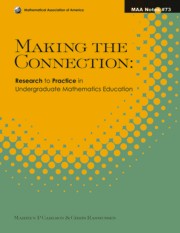Book contents
- Frontmatter
- Preface
- Contents
- Part 1 Student Thinking
- 1a Foundations for Beginning Calculus
- 1b Infinity, Limit and Divisibility
- 5 Developing Notions of Infinity
- 6 Layers of Abstraction: Theory and Design for the Instruction of Limit Concepts
- 7 Divisibility and Transparency of Number Representations
- 1c Proving Theorems
- 8 Overcoming Students' Difficulties in Learning to Understand and Construct Proofs
- 9 Mathematical Induction: Cognitive and Instructional Considerations
- 10 Proving Starting from Informal Notions of Symmetry and Transformations
- 11 Teaching and Learning Group Theory
- 12 Teaching for Understanding: A Case of Students' Learning to Use the Uniqueness Theorem as a Tool in Differential Equations
- Part 2 Cross-Cutting Themes
- About the Editors
6 - Layers of Abstraction: Theory and Design for the Instruction of Limit Concepts
from Part 1 - Student Thinking
- Frontmatter
- Preface
- Contents
- Part 1 Student Thinking
- 1a Foundations for Beginning Calculus
- 1b Infinity, Limit and Divisibility
- 5 Developing Notions of Infinity
- 6 Layers of Abstraction: Theory and Design for the Instruction of Limit Concepts
- 7 Divisibility and Transparency of Number Representations
- 1c Proving Theorems
- 8 Overcoming Students' Difficulties in Learning to Understand and Construct Proofs
- 9 Mathematical Induction: Cognitive and Instructional Considerations
- 10 Proving Starting from Informal Notions of Symmetry and Transformations
- 11 Teaching and Learning Group Theory
- 12 Teaching for Understanding: A Case of Students' Learning to Use the Uniqueness Theorem as a Tool in Differential Equations
- Part 2 Cross-Cutting Themes
- About the Editors
Summary
Imagine asking a first-semester calculus student to explain the definition of the derivative using the epsilon-delta definition of a limit. Given the difficulty of each of these concepts for students in such a course, you might not be surprised at the array of confused responses generated by a question requiring understanding of both. Since the central ideas in calculus are defined in terms of limits, research on students' understanding of limits and the ways in which they can develop more powerful ways of reasoning about them has significant implications for instructional design. Throughout this paper we will focus on calculus courses intended as an appropriate introduction for students who have never seen limits or derivatives and that are not intended to be a rigorous treatment of analysis. The following typical response to the question relating the definitions of limit and the derivative illustrates the confusion that students exhibit when trying to make such connections. This response was offered by an A-student, who we will call Bob, during a clinical interview late in a first-semester course:
Your epsilon — this — the slope of this tangent line. You want to pick a set of x's, and that's here [points at graph]. This x, it's barely changing such that it's equal to or less than this tangent line. That would be your delta. The slope — oh, OK. The slope of this tangent line [points at tangent] — that's epsilon. […]
- Type
- Chapter
- Information
- Making the ConnectionResearch and Teaching in Undergraduate Mathematics Education, pp. 65 - 80Publisher: Mathematical Association of AmericaPrint publication year: 2008
- 19
- Cited by



